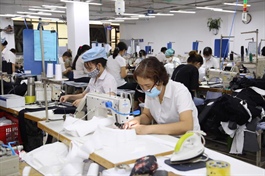EU doors open wider for Vietnamese wood, furniture
EU doors open wider for Vietnamese wood, furniture
Viet Nam has ample opportunities to boost exports of wooden products and furniture to the EU market in the post pandemic period, experts say.

Speaking at a seminar organised on Tuesday by the HCM City Investment and Trade Promotion Center (ITPC), its deputy director Nguyen Tuan said the EU was among the top 15 importers of wooden furniture, handicrafts and interior and exterior decoration products from Viet Nam.
As of 2020, Germany remained Viet Nam’s leading European importer of interior and exterior wood products with 22 per cent of imports, followed by the Netherlands (13 per cent), the UK (12 per cent) and France (11 per cent), Italy (4.6 per cent) and Belgium (4.5 per cent).
However, the pandemic has strongly impacted economies around the world, including the EU, affecting exports to this major market.
Furthermore, the ongoing Russia-Ukraine conflict has triggered an economic crisis in the EU, directly affecting people’s lives, changing tastes, needs and trends in shopping and consumption of the products.
Christine Le, senior business development manager at Bureau Veritas, said it was important to comply with quality and sustainability requirements to export to the EU market.
“To penetrate the market, good quality is the first thing firms need to have.”
European consumers also want to know about labour conditions and corporate social responsibility standards, she said.
Nguyen Chanh Phuong, deputy chairman of the Handicraft and Wood Industry Association of HCM City, said Vietnamese exporters have benefited from free trade agreements like the EU-Viet Nam Free Trade Agreement and the Comprehensive and Progressive Agreement for Trans-Pacific Partnership, making them more competitive and enabling export market expansion.
Many enterprises in the wood industry have received enough orders to keep their workers busy throughout the third quarter and even until the end of this year thanks to quick resumption of production.
The industry has seen slight growth in the first quarter of 2022, with exports of wood and wooden furniture rising 3 per cent year on year to US$3.94 billion.
Difficulties continue
Exporters of furniture and other wood products face several challenges including shortage of raw materials, increase in raw material prices, labour shortage and factory capacity, experts said at the seminar.
High logistics cost is another challenge, caused by supply chain disruptions.
Enterprises also face trade barriers and intense competition from other exporters.
Exporters need to ensure legal timber sources by increasing import of raw materials from low-risk countries, connecting with importers in developed countries and investing in growing timber in Viet Nam, the experts said.
They also need to pay attention to branding, product design and pricing to ensure that they remain competitive, they added.
Despite experiencing a challenging 2021 due to the pandemic, exports of wooden furniture, handicrafts and interior and exterior products reached $14.5 billion last year, up 17.2 per cent compared to 2020.
Viet Nam exports wooden furniture, handicrafts, and interior and exterior products to some 140 countries and territories, with the EU, the US, Japan, China, and South Korea being the main markets.





















